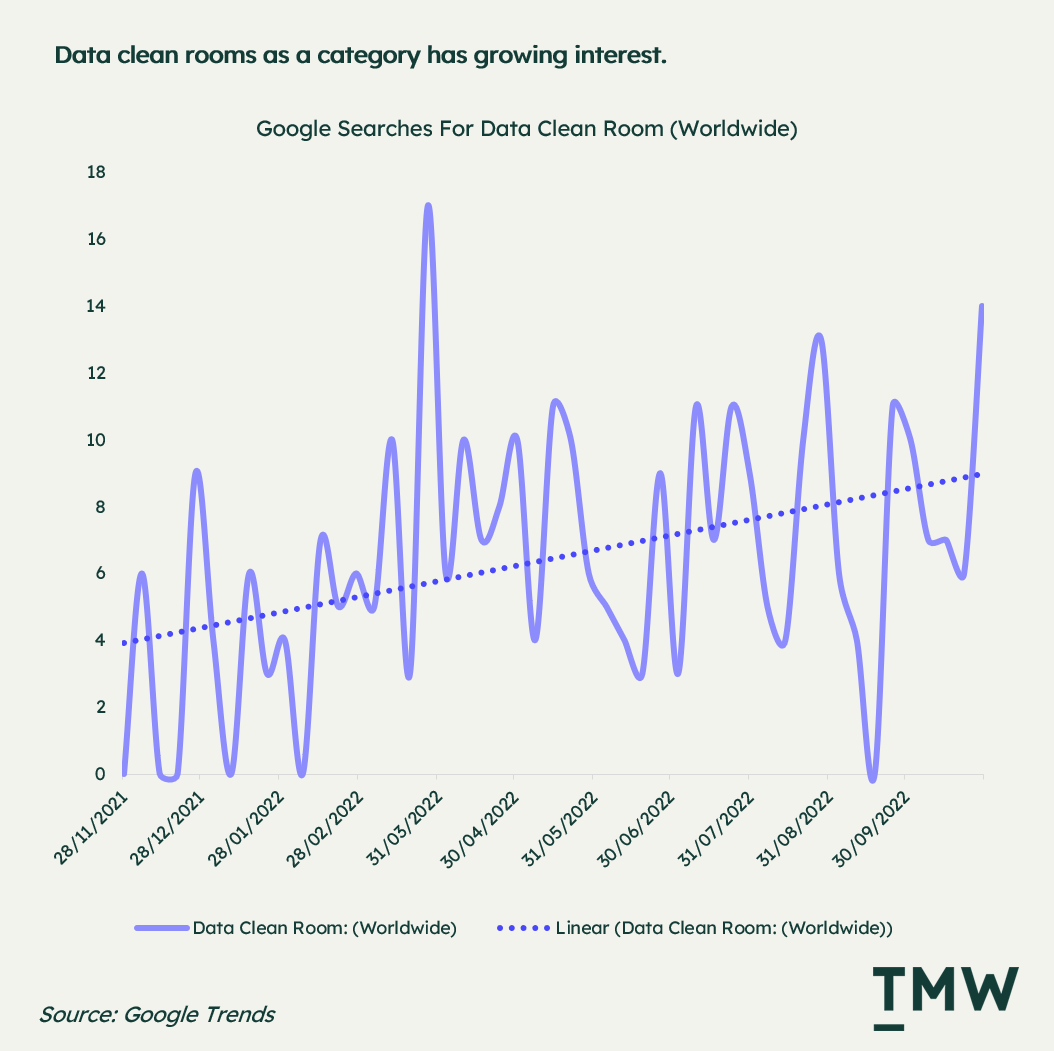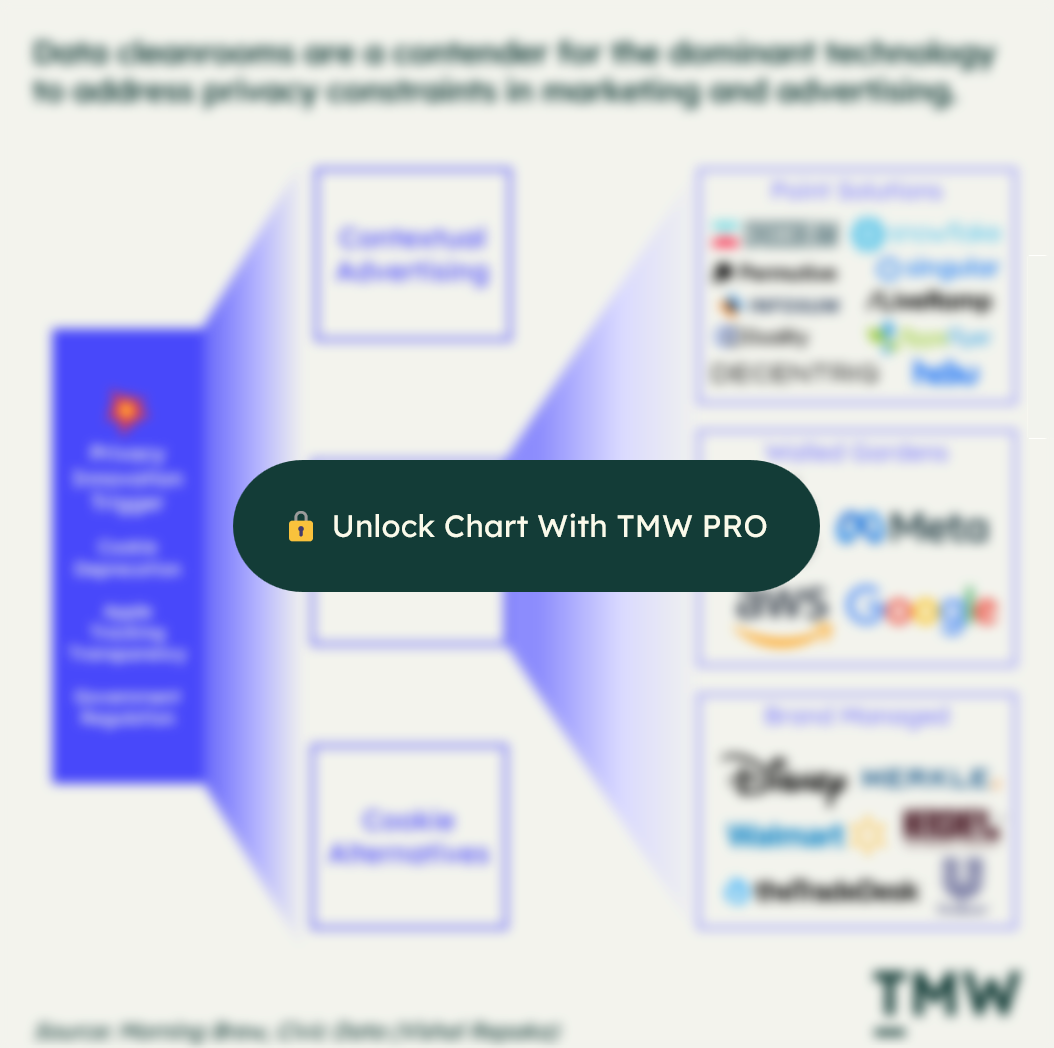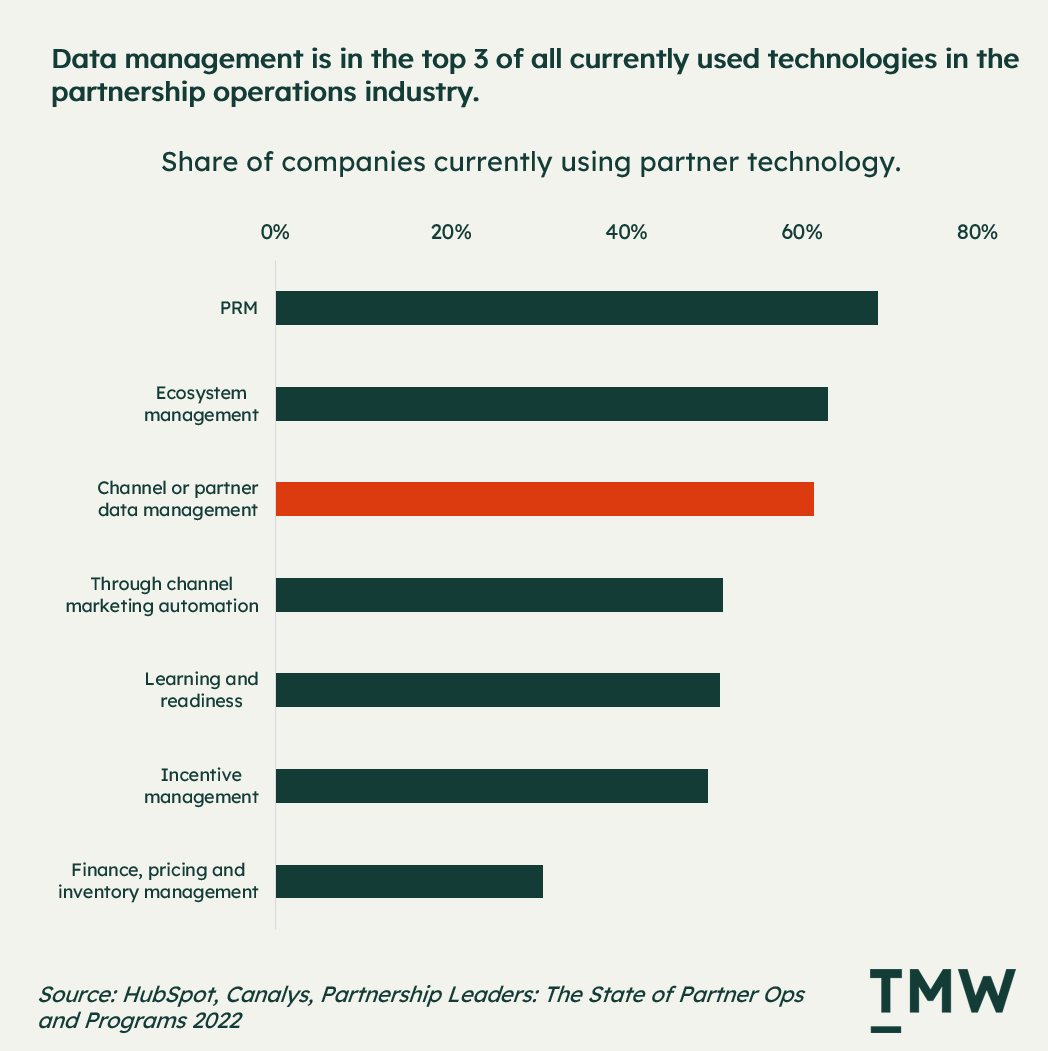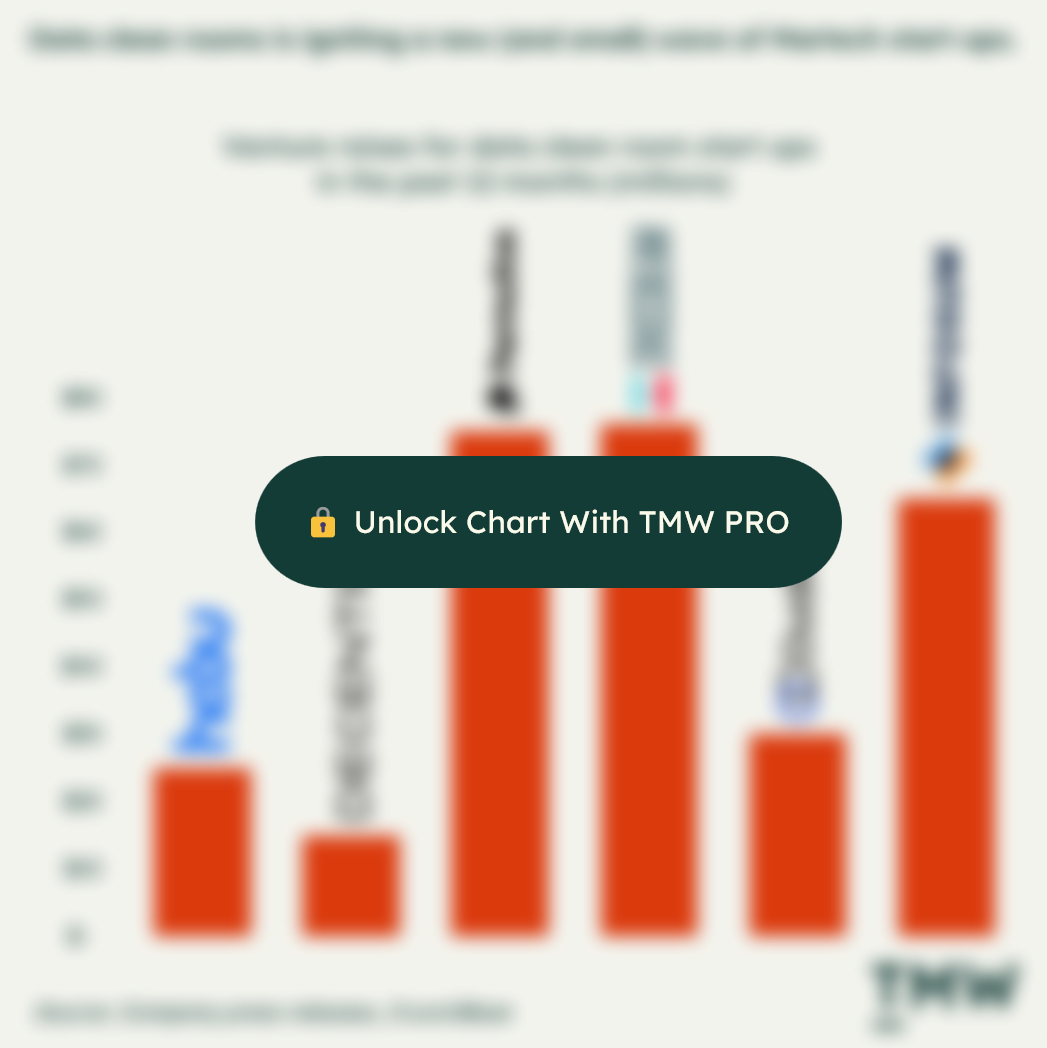TMW #105 | Clean rooms, collaboration and control
👋 Get TMW every Sunday
TMW is the fastest and easiest way to stay ahead of the Martech industry. Sign up to get the full version delivered every Sunday for this and every TMW, along with an invite to the TMW community. Learn more here.
Whenever I read an article about data clean rooms, I immediately think about this scene from the Matrix:

In the movie, this white space, called the Construct, functions as a liminal space between the real world and the Matrix – a digital version of it. Data clean rooms play a similar role: a kind of purgatory for advertising data.
As a somewhat mysterious yet in-demand technology of late, data clean rooms play an important role in the ongoing privacy response in advertising and analytics. There’s an entire industry growing up around the idea that companies should be able to share customer data anonymously and privately to do things like targeted advertising and shared analytics.
But what role do data clean rooms play in the broader Martech industry? And why are companies like Amazon, Walmart, Unilever, and Apple investing in the technology?
Come with me as I explore the white space.
I. Clean rooms
Data clean rooms were born on the altar of cookie deprecation. As one technology reaches the end of its life cycle, another rises to take its place. As third-party cookies go out of fashion, the rise in consumer privacy protection concerns is forcing the hand of the entire Adtech industry.
Jose Uzcategui says it well:
“Undoubtedly, Google Chrome phasing out third-party cookies is disrupting. It says goodbye to the technology that uplifted the industry to what it is today. It introduces complexity and new ad tech and forces the industry to find alternative approaches to achieve the same objective.”
The changing landscape of third-party tracking, and new privacy regulation legislation is rolling into new states in the US, adding additional pressure for brands to comply with ever-shifting data-sharing rules. Consumer brand Sephora was fined recently for illegally selling customer data to third parties, while just this week Discord was fined by the GDPR for failing to implement a data retention and information security policy. These examples are the canary in the coal mine of consumer-facing brands having to reckon with the enforcement of global data protection regulation.
Add to this Apple’s data restrictions on Safari, iOS apps and identity masking features like Private Relay and Hide My Email, and you have pressure mounting from all sides. From browsers to smartphones, the very identity of a customer is changing around marketers and advertisers.
This brings us to data clean rooms. As I wrote on the rise of retail media, marketers and advertisers have been scrambling for a scalable and cost-effective way to target users with ads outside of channels that rely on third-party tracking. One direction is the opening of new ad networks on Amazon and Walmart; the other direction is fundamental changes to how data is shared between companies: the data clean room.
It's no wonder why there have been so much media tracking data clean rooms. It’s one of several key responses to the question of how marketers can get the same results through targeted, programmatic digital ads. And as each month progresses into the privacy winter, the return on the ad spend equation gets worse. Demand is growing for data clean rooms as a way to replace some of the capabilities of third-party cookies, but in a safer, more private way.

Third-party cookies functioned as an open-source way for companies to share data with publishers and other sites. This data sharing mechanism allowed a brand to track that you’ve already visited three other retailers before they see an ad. Like HTTPS, SMTP and RSS, it was an open technology; controlled by few, but the process relied heavily on a distributed network of trackers and publishers.
But that left a gaping hole in privacy protection that the ICCL says is now a systemic risk. Real-Time Bidding (RTB), the main mechanism for targeting users with programmatic advertising, is processing and passing personal data more than 294 billion times a day according to their most recent report.
Something new had to happen. And data clean rooms are one area of innovation that could unlock a new way for companies to continue to share valuable user-targeting data to drive personalised ads and experiences. In the shifting sands of Adtech, some areas are collapsing, while others are growing. That’s why some of the world’s largest publishers have built data clean room products. It’s just one of many bets on the future of targeted advertising on the web.
Within the data clean room category, there is a large variance in companies and approaches. All of them solve the unique problem of data sharing between brands, publishers and platforms, and all of them hold some form of algorithmic masking of identities.
A TMW subscriber, Vishal Repaka recently pointed out to me that within the data clean room category, there are three iterations of the technology:
- Walled gardens that are solutions to plug into the existing mainstream advertising solutions from companies like Amazon and Google;
- Point solutions that are building products on the premise that a brand should be able to share data beyond the existing platforms; and
- Brand-managed clean rooms, designed for specific-use cases for a brand like Disney.

Regardless of the specific solution, the core idea of a data clean room is that it helps companies partner with each other using customer data. Data sharing takes the form of matching first-party customer data anonymously to find common segments and demographics for ad targeting. Clean rooms also enable ways to derive analytics from ad performance and user behaviours with data that is usually aggregated and anonymised. In short, the clean room is a new technology that makes new partnerships possible.
II. Collaboration
New technologies force issues in companies. The capability to do something new, like sell on a website, programmatic advertising, or automating communications with customers, often causes a rethink about how you’re doing business.
Data clean rooms are no different. Like marketing automation platforms, digital advertising, and customer data platforms before it, clean rooms play an important role in facilitating the collaborative aspects of digital advertising. In other words, sharing is caring.
Because data clean rooms act as a kind of Switzerland for data, advertisers and brands can expose data points that they want, with more control over what data is stored and how it is used than third-party tracking – an often opaque and complex format of data sharing between websites and apps. This means that both parties should have a more balanced partnership, as the data shared is valuable to both sides. There’s an equality to this format that is rarely seen in most advertising situations. Usually, one side has all the data.
This expands to how brands are evolving their approach to partnerships. A recent HubSpot report, produced in conjunction with Canalys and Partnership Leaders, suggests that more than 60% of companies are now leveraging technologies to collaborate and share data between publishers, brands, technology partners, and more.

III. Control
Data clean rooms sound like a marvelous idea until one gets hacked or customer identities are leaked and sold on the black market. It’s curious to me that the trend for data clean rooms is mostly platform driven: Amazon, Apple, and Google all have data clean rooms. In some ways, this opens up more risks than rewards for brands that are wanting to break free from platform reliance in advertising and marketing.
What happens when an advertiser controls the majority of your advertising data? They become Google. Data clean rooms raise important questions about control and access. When sensitive identifiers are obscured, this does two things: firstly, it emboldens publishers to offer more detailed and sophisticated targeting under the guise of privacy; and secondly, it gives the providers of these technologies even more power over data management.
Kelly Leger, MD at Deloitte Digital, puts it this way:
“The campaign and insights from that walled garden or that digital giant can’t leave that clean room, but can definitely help you optimize, create better targeting capabilities and enable the ability to better refine all of your advertising within that platform.”
Third-party cookies didn’t start with the kinds of invasive microtargeting and privacy abuses it’s known for now. In the same way, clean rooms may have the same issues in years to come. Why? When you can’t see what’s inside the black box, you can’t regulate what’s going on in there. This is the double-edged sword of privacy: you can mask users’ identities, but it’s almost impossible to verify that you’re doing that, or if it’s as robust as it should be.
You can’t control what you can’t see.
Another open question about data clean rooms is: how much control does the consumer get to have? Given that the data is aggregated, matched, and used anonymously, consumers should have control over how this data is managed from an ethical standpoint.
Privacy policies are used to cover third-party cookies in a variety of ways, but how much can the customer know if we’re going to ask them if it’s ok to de-personalise their data so we can send it to another company? If we gave customers the option in clear terms, we would probably end up with ATT levels of rejection.
This is why decentralised clean room products like Decentriq can help bridge the data sharing chasm that’s opening up in advertising. This growing startup category is addressing the centralised problem of data clean rooms, in that going to Amazon or Google means having to master each way of ingesting, matching and activating that data.
And VCs seem to agree that this is a problem worth tackling. While Amazon, Google, Meta and Apple build their own clean room silos, brands won’t want to have to work with each individual system. But what if there was a way to create the same kind of capabilities without the silos? Private, compliant data sharing in a way that’s scalable would certainly save a lot of companies time and effort.

Whoever gets to own the magical black box gets to own both the mechanisms for keeping customer data safe, and the gateway to targeted advertising in a world that’s closing all the ports.
Clean rooms exist because advertising must exist on the internet if the major platforms we rely on continue to be free or low-cost. But at this stage in the data sharing economy, are data clean rooms the right solution? In many ways, the answer is yes, there’s potential to unlock a lot of value between brands, publishers and platforms. But we must be mindful of not recreating another third-party cookie that’s slightly more anonymised, and more controlled by the dominating platforms.
In the white space of data clean rooms, there’s a lot of promise for new ways to share data between companies. Right now, it’s still a blank canvas, with only a handful of startups. I suspect that will change.
Stay Curious,
💼 The market review preview:
- Has Alexa failed? It's tough to generate revenue with voice
- GPT-4 might be coming soon. And it will be 500x more powerful
- AI and content licensing. Shutterstock is on its knees
- China’s global ambitions. $426b in eCommerce revenue outside of China
- Everything else: Monetizing WhatsApp, Optimizely on the warehouse, Apple’s advertising backflips, the end of boom times, CCPA’s impact, NERFs, and your thanksgiving internet bingo card 🦃
Get the Wednesday Market Review email with a TMW PRO Subscription. It's the easiest way to stay updated on the marketing technology industry. Try it for free for 30 days.
Make sense of marketing technology.
Sign up now to get TMW delivered to your inbox every Sunday evening plus an invite to the slack community.
Want to share something interesting or be featured in The Martech Weekly? Drop me a line at juan@themartechweekly.com.
